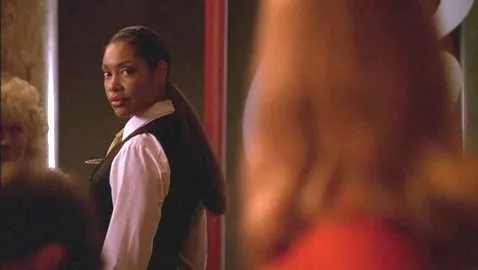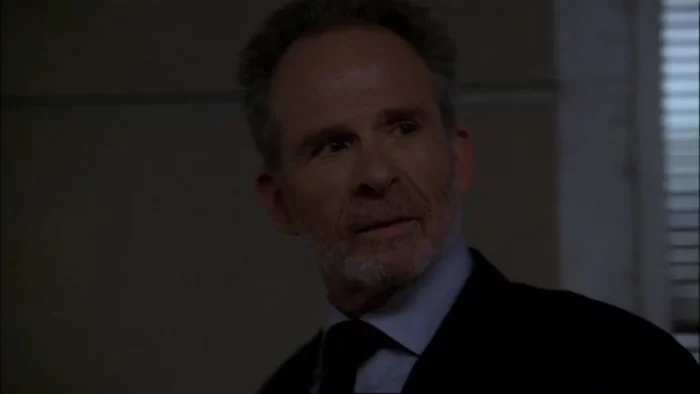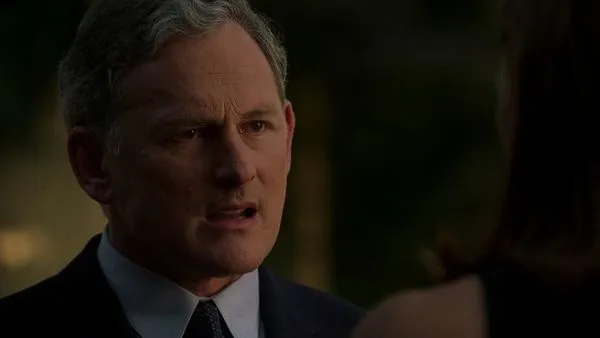The following contains spoilers for Alias S1E3, “Parity” (written by Alex Kurtzman & Roberto Orci and directed by Mikael Salomon)
If Alias, in its opening two introductory episodes, flirted with the idea that the show is a post-Cold War espionage thriller attempting to understand and resolve the consequences of the 20th century’s longest-running and defining ideological conflict, then “Parity” absolutely goes for broke and seals the deal with a loving kiss.
The third episode, the first not penned directly by series creator J.J. Abrams, cements and solidifies existing, introductory concepts and brings in key new ones which will help frame Alias as a show with a sense of unique, genre identity. In many respects, Alex Kurtzman-Counter (as he was named originally, before losing the Counter) and Roberto Orci’s script is one of the most crucial in Alias’ first season.
It is the first episode which directly picks up from the cliffhanger established in the previous episode. It introduces one of the most interesting (and underused) characters the show ever gave us. And, most importantly, it truly kickstarts the mythology Alias would embrace, grapple with, struggle with, and never truly satisfy its audience with over the next five years. “Parity” is a key early touchstone for Abrams’ series.
In discussing “So It Begins…“ I talked about how Alias moved to evolve the idea of the ‘previously on’ segment which American television had embraced as an established part of continuing drama for decades, since indeed the early 1950s with The Life and Legend of Wyatt Earp, one of the first TV shows to adopt the concept as a way of catching viewers up with a ‘recap’, just in case they had not watched the previous week. This has become less common in recent years as TV shows are digested in a ‘binge’ format via streaming services, or accepted wisdom means viewers are more likely to watch a serialised show week by week and not miss episodes, therefore not being in need of any recap.
Alias adopts the recap in “Parity” for the first time, but it builds on the unique ‘concept’ recap that it introduced in “So It Begins…” designed to remind viewers of Syd’s complicated situation before you even get to what happened in the previous episode. “Parity” then throws us right into the resolution of the cliffhanger from last week’s episode, and Alias starts to establish itself as a show which doesn’t need the same continuing story, a la two-part episodes of traditional network series, to carry over characters and plot lines between otherwise completely unconnected episodes. Ineni Hassan won’t reappear fully until “Spirit” after his brief turn here, but Alias works hard enough to set him up as a potentially recurring villain before spiralling off into this week’s story.

John Eisendrath, one of the staff team, talks in Alias Declassified: The Official Companion, about how this attempt to bookend each episode of Alias with a resolution and cliffhanger was a very intentional stylistic choice from the beginning, known as the ‘fifth-act motif’:
In the typical four-act show, an episode opens with a one or two minute teaser, goes right to a commercial, and the end of the third act is when the character is in greatest peril. But, from the beginning, we discussed having our episodes end as often as possible with Sydney in jeopardy and the next episode opening with her figuring out how to extricate herself. So our show usually opens with a resolution of the previous episode’s cliffhanger—and goes on for eight or ten minutes before the first commercial. We essentially decided to go with five acts.
To modern audiences, this kind of connected serialisation doesn’t feel particularly innovative, with a whole host of shows operating on similar lines—Agents of S.H.I.E.L.D., very much an heir apparent to Alias in terms of texture and feel, is a key example. In 2001 nonetheless, Alias actively encouraging a return to sprightly, 1960s escapism in this manner felt new again, giving Alias that energetic spring in its step that marks it out from the beginning as a show with chutzpah. Particularly given how quickly “Parity” moves to resolve how “So It Begins…” ends, contrasting these ludicrous spy scenarios with the grounding of Syd’s ‘real’ life in college. “You’re dropping the ball,” her professor remarks as Syd literally struggles to catch a plutonium core. Alias is cheeky like that.
There are moments in the teaser which date the show, it has to be said. In portraying the dichotomy of Syd’s attempts to pass English in college, with her hopes to become a teacher in the vein of her late mother still a factor in her process, her professor remarks: “You do have email, don’t you?” Moments later Syd gets a beep from Sloane on her pager. I always remember Alias feeling like it was fully in the 21st century back in 2001—a slick show for a new century. Hence the irony how comments such as this very much ground the series in the post-90s landscape, where the internet wasn’t quite yet in everyone’s homes, smartphones or social media didn’t exist, and people in SD-6 and the CIA still were using those PCs with the big, square monitor screens. Alias has become almost as retro as the ’50s & ’60s shows it took a cue from.
“Parity” then, for the first time in Alias, spirals away from the cliffhanger and plot established in “So It Begins…” and heads off in an entirely different direction under Kurtzman & Orci. Let’s talk about those two for a moment because there’s a strong argument they’re the equivalent of Glen Morgan & James Wong for Chris Carter and The X-Files, as they are to Abrams & Alias (if perhaps not quite as uniquely talented). Kurtzman & Orci came up through long-running late-90’s Rob Tapert show Hercules: The Legendary Journeys, cutting their teeth as freelancers, before entering Abrams’ orbit and subsequently staying there; though the duo have now signed deals to work solo, their post-Alias career rocketed them into the cinematic sphere with credits on movies as big as Mission Impossible III and the 2009 Star Trek reboot.
The comparison with Morgan & Wong feels more apparent given how the duo approach the writing process, and how it works in tandem with that of a producing role, summed up here by Kurtzman:
We perceived that there was this kind of a weird disconnect between writers and the studio for a long time in that often people felt like “well, we’ll just hire another writer when we have a problem with a script,” as opposed to having a producer who is also a writer who can talk to other writers in a language that is their own. We always like to think of it as when you’re working with a writer, knowing what size nail you’re going to need and what size screwdriver you’re going to need, what kind of screwdriver you’re going to need. It is a very specific language that writers share so it felt like since we can speak studio language and we can speak writer language, why not try and meld the two.
You can certainly draw parallels in how Carter, of the aforementioned The X-Files, and Abrams both worked to develop teams of writers, or individual talents, who would go on and launch bigger careers beyond Alias. Kurtzman & Orci are the biggest example, arguably, but you can also point to Jeff Pinkner (later one of the principal showrunners of Fringe), Josh Applebaum & Andre Nemec (who ended up penning Mission Impossible: Ghost Protocol), Alison Schapker & Monica Owusu-Breen, the list goes on. Abrams early on with Alias cultivated a team of freelancers and staff writers he would carry through into numerous TV and cinematic projects over the next decade or more, and “Parity” serves as the first example of him handing off the keys to the car to one of these mentees.
“Parity” will go down in the Alias history books for two things, in particular. Firstly, the introduction of Gina Torres as Anna Espinosa, a rival Russian (sort of) agent for Sydney to brush up against and secondly, most importantly, the first mention of Milo Giacomo Rambaldi on the show. Rambaldi is very much an Abrams creation, and can’t be credited to Kurtzman & Orci, but they do the principal work here in establishing the core root of the mythology which will underpin the next five seasons of Alias. It will serve as crucial to this show as alien colonisation does to The X-Files, or the DHARMA Initiative did to Lost, or the White Walkers do Game of Thrones. It is Alias’ distant, almost unknowable, mysterious MacGuffin, and will both enthral and infuriate for years to come.

Abrams explains in Alias Declassified how Rambaldi was created specifically to alter the perception of the show:
For me, [the Rambaldi story] ratchets up the uniqueness of Alias. The show is not just about spies and going after nuclear codes or whatever—it’s about something weirder.
Rambaldi was, of course, named after special-effects maestro Carlo Rambaldi, who worked on amongst other things Alien and E.T: The Extra Terrestrial, for which he won an Academy Award, so it is a significant nod by Abrams to the behind the scenes geniuses on the kind of pictures he grew up watching, but also fits the fact Rambaldi is an inventor. Put simply, here’s the legend: in the late 1400s, Rambaldi was a brilliant scientist in the vein of Leonardo da Vinci who created a lexicon of works centuries ahead of his time; much like Da Vinci devised a rudimentary helicopter, so Rambaldi invents a rudimentary cell phone. Before his name can enter the history books as Leonardo’s did, he is ex-communicated and burned at the stake for heresy by the Catholic Church, who then sent up in flames the majority of his designs and innovations.
We learn a great deal of this information from Arvin Sloane in an SD-6 exposition dump. Sloane claims Rambaldi was killed because he claimed that one day “science would allow us to know God.” This is a key line because it might well be the only time Alias ever mentions God directly in the context of Rambaldi, despite the fact the ‘search’ for the truths he knew would become as religious a quest for Sloane in particular as anything in the Bible. We will discuss this much more in time, but Alias is a remarkably secular show given how crucially faith and religion lie at the heart of the series. Sloane even remarks: “it seems Rambaldi was a prophet”—a very throwaway line with deeply religious connotations. ‘Prophet’ certainly comes up again as a word but after this, Alias assiduously avoids using God at every single turn.
Given this is merely the introduction of Rambaldi, Alias is still figuring out quite what they have here. Why did Abrams wait until Episode 3 to introduce a 500-year old hybrid of Da Vinci and the occult visionary Nostradamus, when “Parity” expressly goes out of the way to link the ‘Mueller Device’ we saw Syd go after in “Truth Be Told”, to Rambaldi? It’s a retcon, if anything, this early on—“forget that Mueller guy, he’s not important, the real guy is this old Italian fella.” It’s possible Abrams feared he couldn’t get such a science-fiction concept past the suits at ABC and decided to trickle Rambaldi in once he’d gotten a season order. It could actually have been a wise move, given we don’t lose much by Mueller having simply been copying older designs.
Kurtzman & Orci are charged, however, with trying to lay down base characteristics for Sloane too in “Parity.” It takes Alias quite some time to really start exploring Sloane’s underlying psychology; “Spirit” is a key moment, while so too are episodes such as “The Box” or “Page 47,” before the end of Season 1 and a large amount of Season 2 squares the focus onto him. For the first half of Season 1, however, Sloane remains distant and enigmatic, but “Parity” has to plant foundations episodes such as “Page 47” can build on. You wonder if Sloane intentionally plays down his fascination with Rambaldi to Syd & co here, or the writers hadn’t yet figured it out. “I’m not a New Age kind of guy, I don’t believe in the ‘power of the Pyramid,’” Sloane claims. We’ll find out later this isn’t strictly true at all.
In hindsight, it’s fun to look back on Season 1, knowing Sloane has been obsessed with Rambaldi for decades and has quietly been collecting bits and pieces, and see where Sloane tries to take opportunities to acquire Rambaldi arcanum under the purview of the Alliance. Yet Alias here still works to underplay him as a pragmatist, and still the ‘meat and potatoes’ spy boss who just wants to prevent ‘the other side’ getting hold of the goods. This is where Rambaldi factors into the broader allegorical Cold War ideas in play with “Parity,” because this episode establishes very much that Rambaldi, in the underground world of hi-tech espionage, has fast become the new ‘Space Race.’ The super powers are now just looking back, instead of forward.

This makes sense. America and Russia have been in a perpetual state of tentative glasnost for a decade now, as Alias comes to life. Bigger immediate threats are emerging in the Middle East, which Alias leaves to more ‘realistic’ espionage shows such as 24, but the shadow of the Cold War remains towering over the American psychology. The Russian fear is actualised in Alias with agencies such as K-Directorate (just the KGB with a made up name), or the Derevko sisters who will later make their mark as private, international organised criminals. These agencies and characters are a proxy for the same fears, as is SD-6 as the fear of an internalised American corruption by enemy forces, so it makes sense for Alias to introduce a new, shared conflict for both sides to focus their energies on.
Alias feels a lot like a show trying to work out where America and Russia stand with each other in the 21st century. Looking back at a figure like Rambaldi is almost akin to looking back at their own history, trying to unpick how they got to where they are, and worrying deeply about what history may deliver upon the future; Rambaldi’s innovations almost always seem to lead to a weapon of mass destruction of some kind. Does he represent a genuine fear of the unknown new century and where these two great powers may figure within it? Possibly. Anna Espinosa certainly seems to exemplify how this idealogical conflict is being actualised through both her and Syd’s characters on a ground level: Anna is the mysterious Russian bear, while Syd is the all-American girl trying to protect and serve.
Anna is even described by Syd as “one of the last Cold War babies,” given her dual Russian and Cuban heritage, and this genealogical background seems very pointed: the Soviet Union and Cuba, under Fidel Castro, were famously allies given their shared Communist rule, which came to bear on America most famously in 1962’s Cuban Missile Crisis—the closest both super powers ever came to abandoning Mutually Assured Destruction since the end of WW2. Syd & Anna’s mostly unspoken but clear backstory and antipathy might as well be that of America & Russia; aware they’re no longer outright enemies, but neither trust each other, they would probably betray each other, and they would kill each other if it benefited their own agency (read: country). Perhaps Anna more than Syd, but still—Syd openly laughs at the idea she should trust Anna, which suggests America can’t trust Russia even after the long-standing detente which now exists. This mistrust arguably carries through into dealings with her mother Irina and beyond much later.
“Parity” works this ideological contrast into the climax of the plot, as Syd & Anna both have to meet on neutral ground in order to open a box containing a key Rambaldi artefact, given both sides have a crucial component the other needs to see what’s inside. They even meet in Berlin, the historic crux point as the capital of Germany, which only in the last decade from when Alias premiered was reunified into one country, after half a century of division between Soviet & Allied forces. Jack Bristow describes the arrangement as a “mutually reinforcing course of action” but he might as well be talking about MAD all over again. Syd (America) and Anna (Russia) have to work together in order to gain equal footing in their new race for supremacy: not over the bomb, or space, but over Rambaldi’s work itself.
If Rambaldi’s work, and its true purpose, have remained secret all of these years, then secrets remain a key component of “Parity” when it comes to certain of its characters. They are naturally key to Syd’s life, given she has to hide who she really is from her friends, but Will continues to quietly look into Danny’s death behind everyone’s back, and even Francie fears her boyfriend Charlie is secretly seeing another woman. Most appropriately, however, secrets are being guarded by Jack—who is at pains to try and keep Syd from asking the understandable questions she now has about him, and about her mother, having learned that Jack works for SD-6 and the CIA. “This isn’t the time,” he tells her at first, given Syd is again not thinking clearly about her covert situation when she approaches her father to have the conversation publicly.
Sloane seems to keep trying to re-introduce Jack to Sydney, oddly enough, here as SD-6’s “finest game theorist.” He first in “So It Begins…” showed Syd, out of the blue, that Jack was part of the agency, and here for the first time brings Jack in on one of Syd’s missions. He seems to be working hard to normalise their relationship, correcting himself at one point by saying, “Jack thinks—your father thinks…” This could be Jack’s influence, encouraging Sloane to connect he and Syd together via the work in order to facilitate their double agent status, but at this stage we don’t know enough about Jack to truly understand what he’s doing. The ambiguity remains, even if Victor Garber gets across a deep sense that Jack’s motives are honourable.

Nonetheless, he still lies to Syd, as confirmed quietly later to Sloane, about what happened to her mother ‘Laura.’ “She died in the accident,” he claims. “I never lied to you about that.” In some senses this may be seen as a lie, but is it? Knowing that the accident centred around the revelation that Laura was in fact a KGB spy, Jack’s meaning here feels more metaphorical—Irina may have lived, but Laura died the moment her death was faked. Jack may well literally lie but emotionally? We’ll see it’s not quite as straightforward as that. Again, however, “Parity” leaves enough ambiguity there between Jack and Sloane to intrigue.
Alias also continues to approach the younger male cast members, in relation to Syd, in interesting ways. Both Will and Vaughn are looking to be Syd’s knight in shining armour now Danny is gone—Will by trying to figure out his death and Vaughn by remaining her CIA handler. It helps in the latter regard that Lambert, his replacement, turns out to exemplify the kind of loathsome, institutionalised sexist that Syd fears Vaughn might be in the last episode. He even says, lasciviously: “Wouldn’t kick that out of bed” upon seeing an image of Syd—it’s not subtle, and by degrees, Vaughn is both clearly smarter and less of a sleaze, no matter his age or experience. The show doesn’t work hard to re-position Vaughn back as Syd’s “guardian angel,” to the point it feels arbitrary that he was ever briefly taken out of the role.
With Will, it’s a bit more complicated. Syd doesn’t know Vaughn yet, he’s the handsome new guy she is still to form a real attachment to, but Will is her closest male friend and tied up far more emotionally with her life. The moment they drunkenly kiss (which instantly sobers them up) works because we knew straight away Will wanted to be more than just friends, and Jennifer Garner & Bradley Cooper have genuine chemistry—with hindsight, they’re honestly a far better match than Syd & Vaughn ever were, and this will become ever more apparent in Season 3’s “Remnants.” Syd kisses him in this instance but given her loneliness and confusion about every aspect of her life, you understand the context, and why she immediately regrets what happened. It works well even this early on in the show’s life.
“Parity”, therefore, continues the strong opening run Alias is having straight out of the traps. It introduces the core central tenets of the series’ mythology. It continues to deepen character inter-relationships. It introduces broad conceptual and thematic ideas underpinning the show, not to mention narrative stylistics which will become part of Alias’ DNA—even the final moment of Syd saying “oh my God!” at seeing something in a classic Abrams mystery box that we don’t yet understand. It also remains entertainingly light and overblown on the surface, while hinting at the depth that will start trickling in down the road.
It wouldn’t be too much of a stretch to suggest “Parity” is the episode where a lot of Alias’ key foundations truly were laid.

